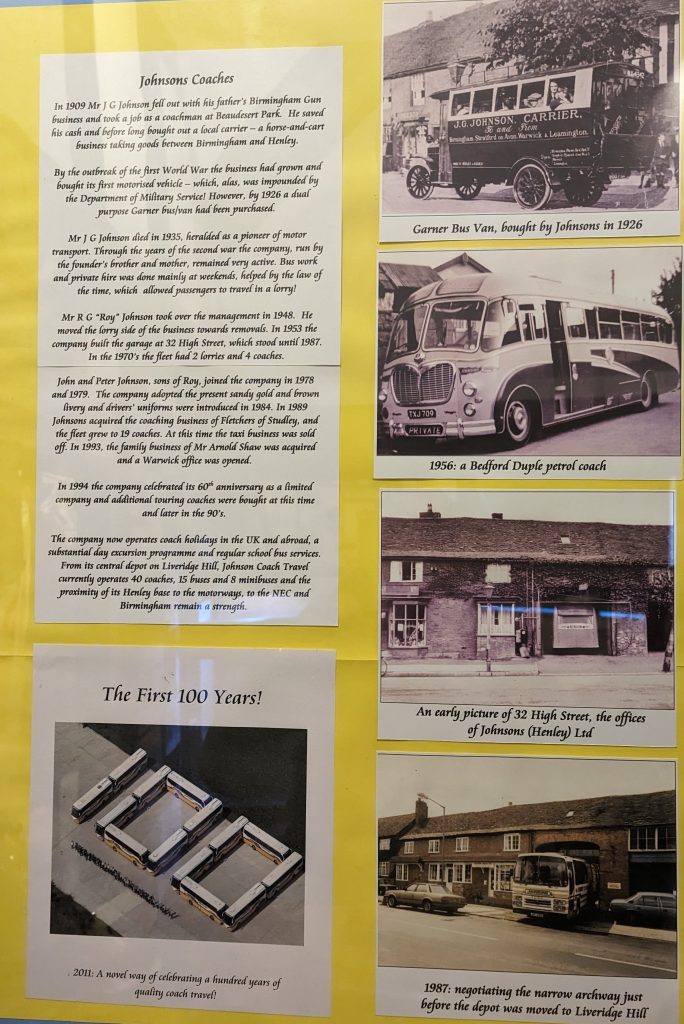I have updated the following two posts:
31st October Halloween
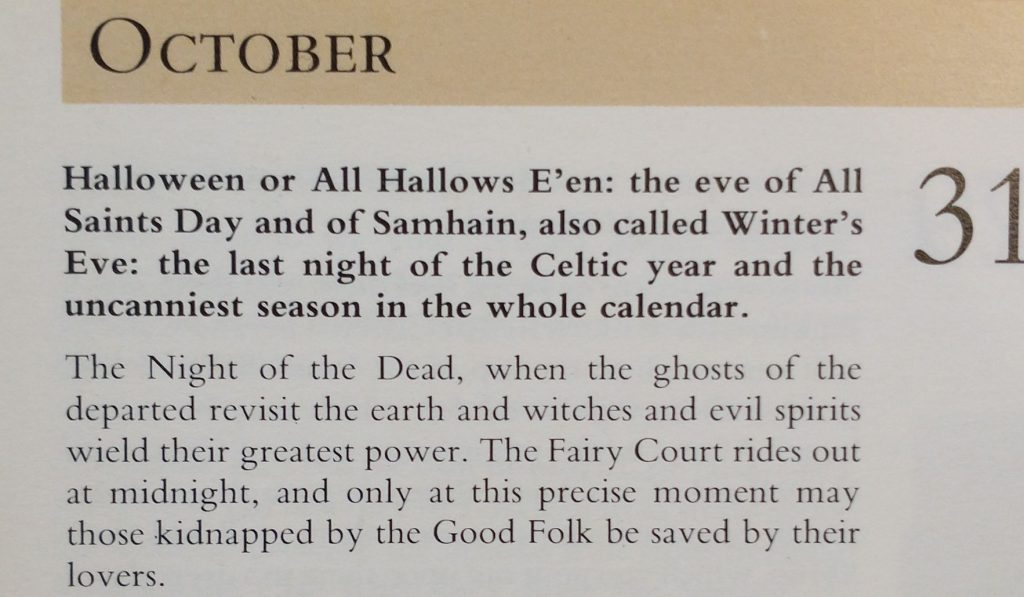
This is a revision of a page I wrote on 31st October 2022.
I began my perpetual Almanac of the Past two years ago on the 31st October 2021. This was the first line:
‘This blog is to celebrate the Year. I will post, hopefully, once a day, so we can follow the seasons, as they happen naturally, and as people in Britain and Ireland have responded to the changes in the year.’
It was inspired by Charles Knightly’s book, which is a pot-pourri of folklore taken mostly from old Almanacs. I haven’t managed to post every day, nearly managed it in the winter but falling badly behind in the Summer when I take Road Scholar groups around the UK. My plan is to improve key posts and repost, and to fill in the gaps. Another aim is to give my Almanac more London specific content.
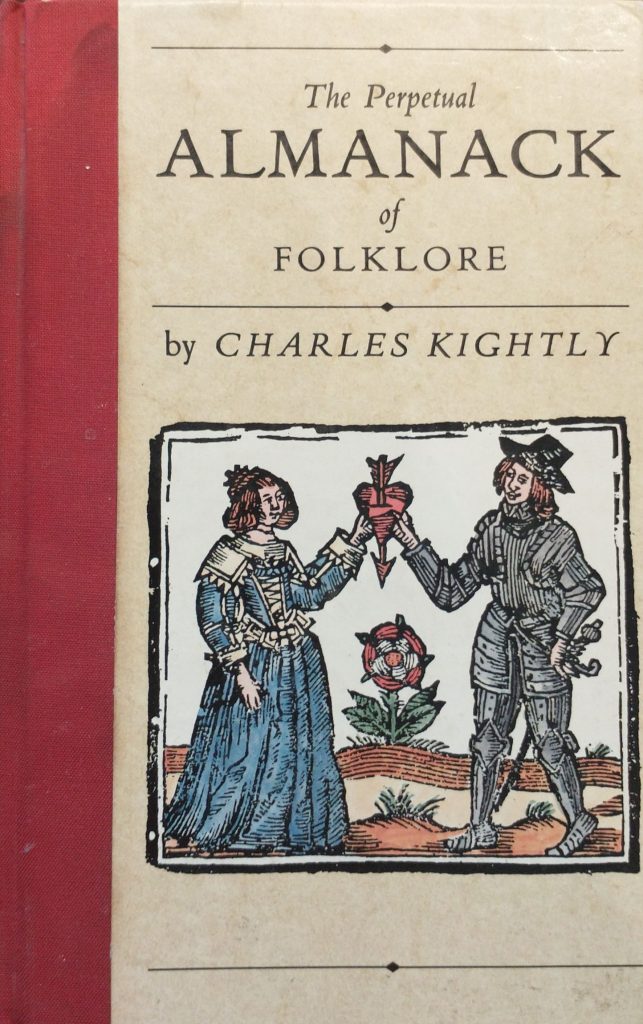
I started on Halloween because Samhain (pronounced Sow-in) was the beginning of the year for the Celtic world. It may mean Summer’s End. In Wales, it is Calan Gaeaf (first day of winter) and Kala Goafiv (beginning of November in Brittany).
For the Romans, it is the day that Adonis is injured hunting a wild boar, against his lover, Venus’s advice, he descends to the underworld. Nature withers and dies until he comes back. His blood stains a flower and was transformed into the Crimson Anemone. There is a similar story in Babylon of Ishtar and Tammuz.

Binyon 1898-1907 / Catalogue of drawings by British artists, and artists of foreign origin working in Great Britain (5(c))
He comes back again on May Day when he meets Venus again the world flourishes and is bright and warm.
Julius Caesar says the Gauls venerated the God Dis Pater on this day – an aspect of Pluto, the God of the Underworld, ruler of the Dead. There was a Roman Festival on the Kalends of November dedicated to Pomona, the goddess of the fruit of trees. This may influence the use of Apples, which are prominent in Halloween festivities.
The End of Hardy’s tree
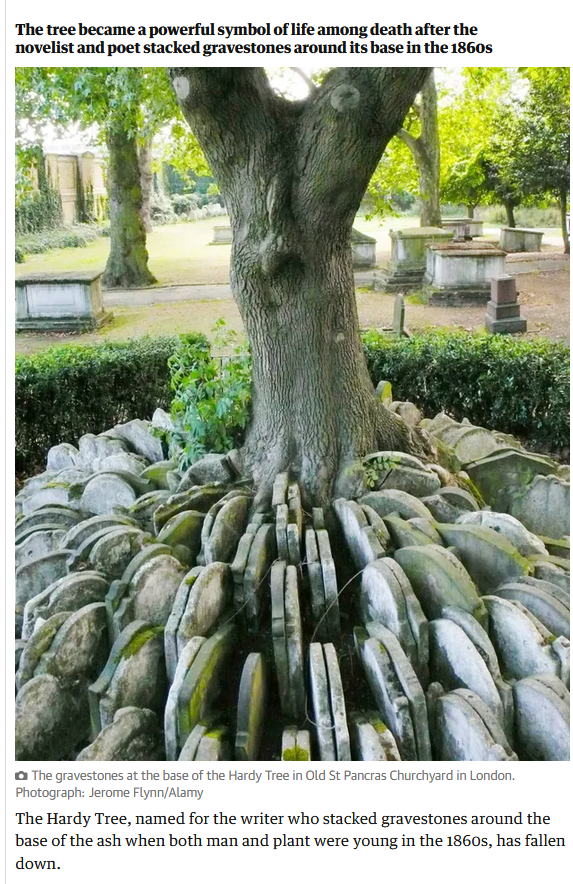
I published the following post about Hardy’s Tree on 28th December 2022. Here, follows the original post and an update which suggests the tree and the gravestones were not erected by Thomas Hardy.
This is the day that Herod ordered the slaughter of the Innocents, or Childermas, and I am glad to see that my Grandson is now older than Herod’s prescription.
Hardy’s Tree in St Pancras Church, Camden, London has fallen down. Hardy was an architect and worked in London for a while, where one of his jobs was to supervise the clearance of the graveyard. Several poems of Hardy refer to the removal of graves from their original positions and in this case, the gravestones were set around an Ash tree that inspires many, including my Central St Martin’s students who used it in a project recently. So, I was shocked to read a Guardian article (since deleted) which noted the sad demise of the Tree.
Extracts from one of several Hardy Poems about moving graves and gravestones follow, but I need to update the post about the connection to Hardy. The Guardian has now got an article which suggests the connection with Hardy is a more recent one than previously thought (Guardian article).
I (and I think the Guardian) were alerted to this by the work of Lester Hillman, who wrote a Churchyard Guide and a recent pamphlet about the Tree, which is reported in ‘Context ISSN 1462-7574’. This is the Journal of the City of London Archaeological Society. Evidence proves that the Ash Tree dates to the 1930s, and that the mound of gravestones is from burials relocated from St Giles in the Fields, and therefore unlikely to have been in St Pancras at the time Hardy was responsible for clearing it.
So it is not ‘the’ Hardy Tree, but then nor was the tree at Sycamore Gap anything to do with Robin Hood. What it was, was a beautiful piece of nature, in a poignant setting. May she rest in peace.
The Levelled Churchyard
Thomas Hardy
O Passenger, pray list and catch
Our sighs and piteous groans,
Half stifled in this jumbled patch
Of wrenched memorial stones!We late-lamented, resting here,
Are mixed to human jam,
And each to each exclaimed in fear,
I know not which I am.Where we are huddled none can trace,
And if our names remain,
They pave some path or porch or place
Where we have never lain!
October Going to the Mop in Stratford-upon-Avon & Henley-in-Arden
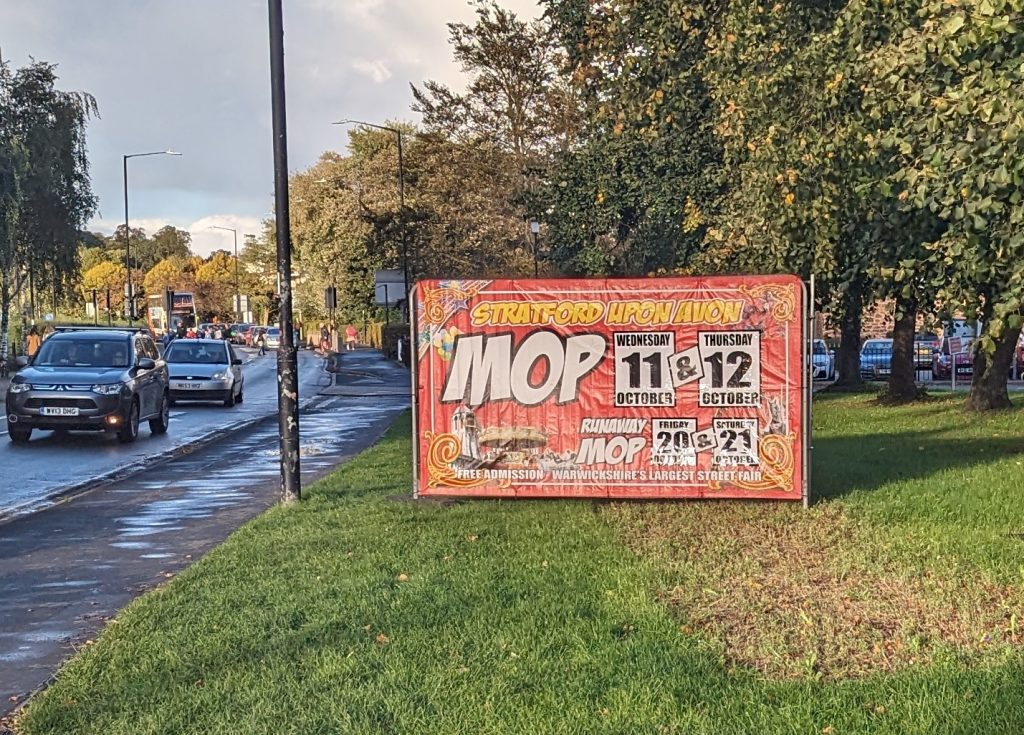
On my way to Stratford-upon-Avon Railway station, I saw this sign, but had no idea what on earth a Mop was.
So I put it to the back of my mind as I took the train to Henley-in-Arden. My interest in the town began, as Shakespeare was born in Henley St in Stratford, and his mother was called Mary of Arden. So, naturally, I wanted to find out about Henley-in-Arden. To turn curiosity to action it took our Tour Coach Driver telling me he lived there and that it was a pretty but small town.
With a free afternoon from my duties as Course Director on the ‘Best of England’ Road Scholar trip, I found myself on the very slow train to Henley-in-Arden. One of the first stops was Wilmcote, where Mary Arden’s House is. I visited last year, when I was astonished to find it was a different building to the one I had visited in the 1990s. In 2000, they discovered they had been showing the wrong building to visitors for years! Mary Arden’s House was, in fact, her neighbour Adam Palmer’s. And her house was Glebe Farm. On that visit, I walked from Anne Hathaway’s Cottage to Mary Arden’s House and back to Stratford along the Stratford Canal – a lovely walk if you are ever in the area.
The train route to Henley was through what remains of the ancient forest of Arden. The forest features in, or inspired, the woody Arcadian idylls which feature in several of Shakespeare’s plays, particularly the Comedies. ‘As You Like It’, for example, is explicitly set in the Forest of Arden, as this quotation from AYL I.i.107 makes clear:
Oliver: Where will the old Duke live?
CHARLES: They say he is already in the Forest of Arden, and a many merry men with him; and there they live like the old Robin Hood of England: they say many young gentlemen flock to him every day, and fleet the time carelessly as they did in the golden world.
Henley-in-Arden turns out to be a quintessentially English little town full of beautiful timber framed buildings and a perfect Guildhall.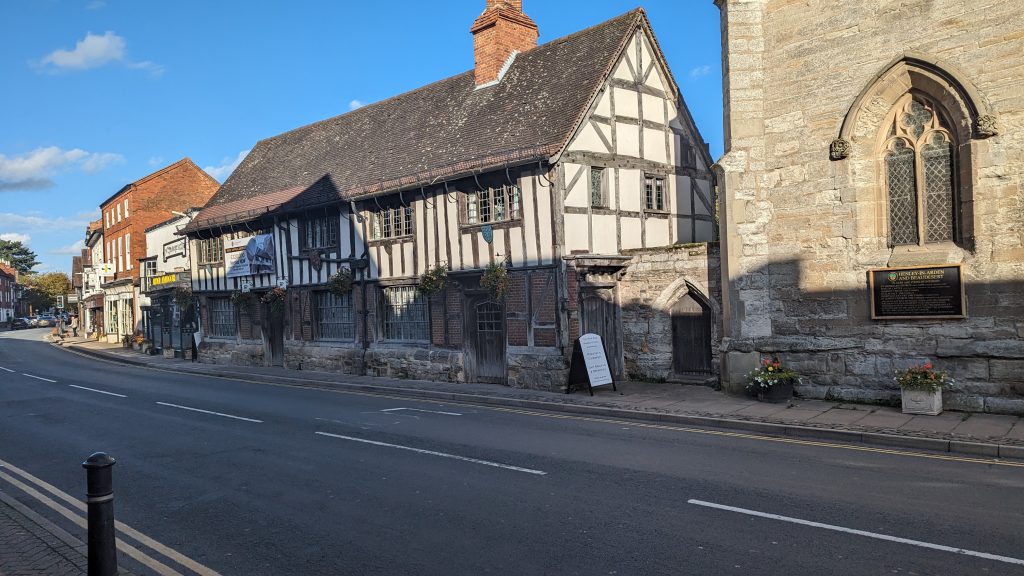
Further down the road is a lovely Heritage Centre full of old-fashioned and DIY Information panels. And that is not a criticism, it provided a very enjoyable visit full of interesting stuff and which gave me a couple of snippets of information I have not seen anywhere else.
So, to get back to the signpost for the Mop, I was delighted to find a panel dedicated to the Henley Mop. A mop turns out to be a hiring fair. Think of Gabriel Oak in Hardy’s ‘Far from the Madding Crowd’. His attempt to become an independent farmer destroyed when his sheepdog runs amok and sends his sheep over a cliff to their doom. So he takes his shepherd’s crock to the hiring fair or Mop as they are known in the Midlands. There, potential employers can size up possible employees and strike mutually agreed terms and conditions. And Gabriel becomes the shepherd for the delightful and wilful Bathsheba Everdene.
So, a shepherd would take his staff, or a loop of wool; a cleaner her mop (hence the name of the fair), a waggoner a piece of whipcord, a shearer their shears etc. Similarly, in the Woodlanders, the cider-maker, Giles Winterborne, brings an apple tree in a tub to Sherborne, to advertise his wares.
The retainers thus employed would be given an advance and would be engaged, normally, for the year. So there was quite a widespread moving around of working people to new jobs and often new housing. Not quite how we imagine the past?
The perceptive among you will have noted the bottom of the sign in Stratford which advertised the ‘Runaway Mop’. This was held later in the year, so that employers could replace those who ran away from their contracts, and where those who ran away could find a better, kinder or more generous boss.
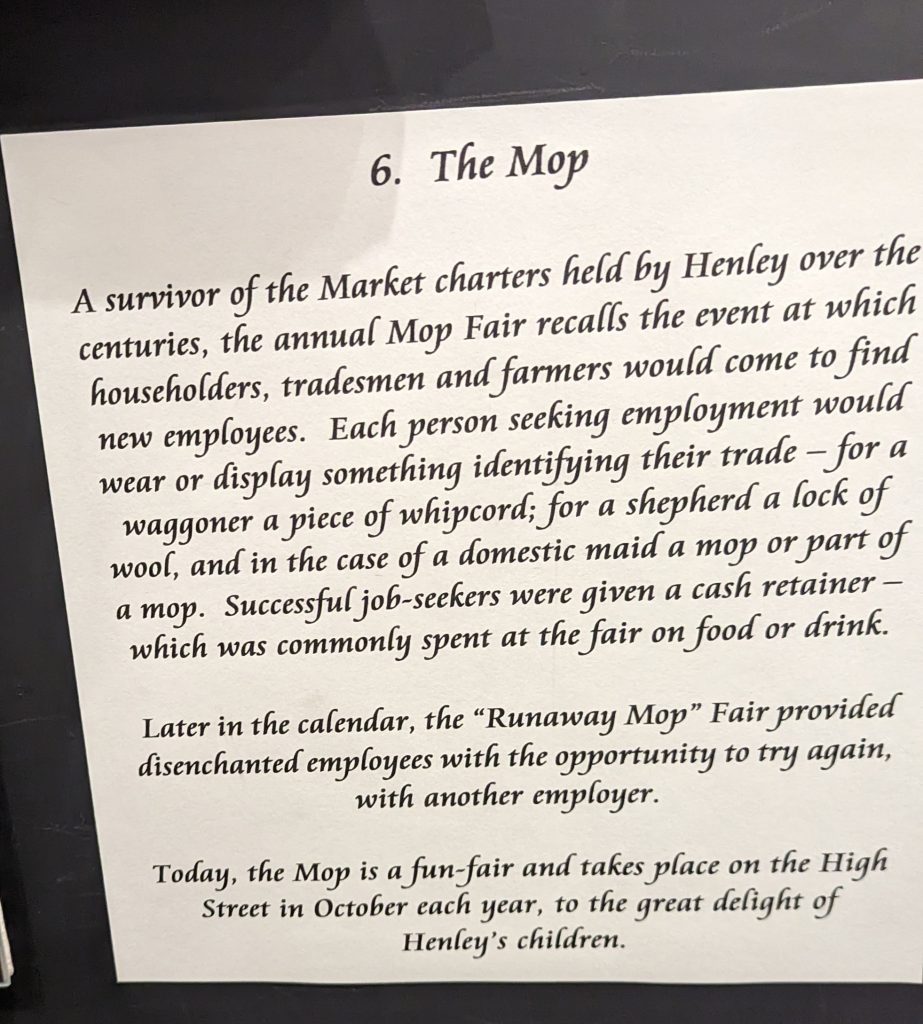
Also of interest to me was the panel about Court Leets and Barons. These were the ancient courts which dealt with, respectively, crime and disorder, and property and neighbourhood disputes. Henley still has its ancient manorial systems in use, at least ceremonially. The Centre shows a video of a cigar-smoking Stetson-wearing large rich American arriving at the Guildhall to take over duties as lord of the manor after purchasing the title.
There was another panel of great interest to me as it told the history of Johnson’s Coach Company which was taking my group around England. And it was a delight to discover that it has a history that can be traced back to 1909 in Henley. I conveyed this information to our group on the following day as we toured the Cotswolds. Curtis, our driver, was able to update the panel and told us that the family were still involved with the firm, which is still operating from the area. He said the two brothers who run the company come in every working day and do everything they require of their drivers to do; i.e. they drive coaches, clean coaches, sweep the floors and generally treat their staff like part of a big family. I should have asked him whether he got his job at the Mop, while holding a steering wheel in his hands!
